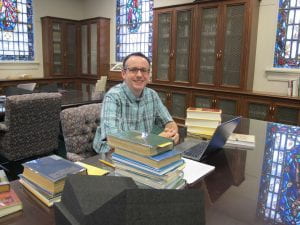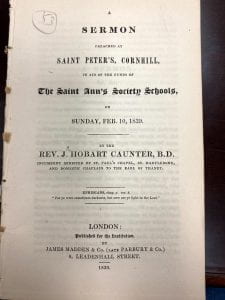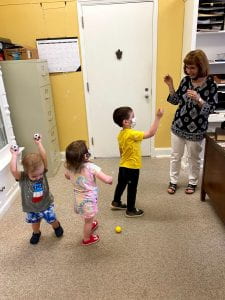By Kevin A. Morrison, PhD, Provincial Chair Professor, University Distinguished Professor, and Professor of British Literature in the School of Foreign Languages at Henan University
Walking into an archive or a special collections reading room, the researcher carries more than a laptop (to record notes) or smart phone (to take pictures of the newspaper cuttings, correspondence, or rare books one is examining). The researcher also brings to bear on the examined material a range of expectations—from the epistemological and the ideological to the identificatory and the mundane. Indeed, perhaps the greatest allure of the archive is not the prospect of obtaining more complete knowledge of one’s subject, aided by a little luck (such as finding an uncatalogued letter, diary entry, or manuscript that solves whatever interpretative mystery has drawn one there in the first place), but of uninterrupted time in which to write and think.
When I arrived at Baylor at the end of April 2021, I (half) expected that life would stop. After all, I had spent the preceding fourteen months under mandated and self-imposed lockdowns. Like many scholars whose work is based in archives, I found such conditions stymying. I would often joke to colleagues that I didn’t know which I was looking forward to more at the conclusion of the pandemic: no longer wearing a mask or no longer having to use HathiTrust. As it happens, over my month-long stay in Waco, both were achieved: I could, once again, hold physical objects from the past in my hands as well as experience, however briefly before the Delta variant took hold, the pleasures of reading in a building without my glasses fogging up.
What I did not experience, however, was undisturbed time in which to work. Instead, family health crises, complicated childcare arrangements, and a flat tire competed with my research priorities and, on occasion, burst my expectational bubble. If the staff of the Armstrong Baylor Library could not solve medical problems, however, they were more than happy to help me get driving again or to offer suggestions of things to do in Waco with children (such as Wacotown Chalk + Walk and the wonderful Mayborn Museum). Nevertheless, I welcomed the opportunity to make progress on a project that, owing to the pandemic, I had deferred for more than a year.
In 2019 I was commissioned by Routledge to produce a five-volume compendium of primary source materials titled Charity and Philanthropy in Nineteenth-Century Britain. The nineteenth century in Britain was a markedly philanthropic and charitable age. Building on trends that began in the 1700s, philanthropic activity and charitable practices became widespread, often institutionally organized and directed, and targeted an astonishingly diverse array of fields: education and child welfare, the arts, family planning, animal welfare, medical reform, and the eradication of social ills. The sources in this five-volume edition will provide a foundational basis for studying the many reasons for giving during this period and the varied practices associated with giving. Each volume will cover a diverse array of fields and, to the extent possible, include national, regional, and local material.
While I will be drawing on material in other archives, for the first volume, tentatively titled “The Spur of Religion,” I was particularly eager to consult the ABL’s collections of tracts and theological pamphlets. Although the concept of charity is arguably rooted in the Old and New Testaments, and the notion of philanthropy emerges in the seventeenth century, it was only in the nineteenth century that both assumed their modern form. The materials in the first volume will provide essential context for understanding the role of religion in nineteenth-century charity and philanthropy. The tracts touch on a range of charitable themes, while the pamphlets provide insight into the religious dimensions of charity and philanthropy. Director Jennifer Borderud helped me navigate these large, and therefore daunting, collections by organizing the material around a number of key terms central to the volumes, including temperance, vivisection, and abolitionism.
After two weeks of working with the tracts and pamphlets, I had one of those epiphanic archival moments that significantly changed how I spent the duration of my visit. Just before the coronavirus pandemic was declared, I was finishing a book manuscript, tentatively titled Studies of Provincial Life: Mitford, Gaskell, Eliot. Although Mary Russell Mitford, Elizabeth Gaskell, and George Eliot were near contemporaries, spanning two generations, and were celebrated for their representations of rural life, the three authors have never been extensively studied together. Readers often considered that the authors’ glimpses of rural life were based on their individual experiences, and their works were marketed accordingly. Yet when Elizabeth Gaskell undertook in 1851 to write the literary sketches for Household Words: A Weekly Journal Conducted by Charles Dickens that would later appear as Cranford (1853), she looked to Mitford. In Our Village (1824–32) Mitford established the prototype of a new genre to which many writers throughout the century attributed aspects of their craft. In turn, when Marian Evans—who had been a journalist, translator, and editor—tried her hand at fiction, the future George Eliot drew inspiration from Cranford and from the thematic and formal techniques of both Gaskell and Mitford. Tracing this chain of influence, my book demonstrates that Mitford, Gaskell, and Eliot, all of whom have often been employed in service to projects of restorative nostalgia that seek to reconstruct the present in the image of the past, worked within a reflective strain that accepted the pastness of the past and embraced change, however reluctantly and wistfully.
By March 2020, I had a working draft of the manuscript. What I did not possess were the many images I had hoped to incorporate. Over the course of writing, I had also come up with a number of very specific questions about the primary sources with which I was working that could be answered only by undertaking significant fact checking. Because I had to scrap my planned summer 2020 trip to London, where I intended to finish the manuscript at the British Library, the project had been on the back burner for more than a year. On a lark, midway through my time in Waco, I decided to see whether the ABL held any of the titles I needed to consult, such as the original eight parts of Eliot’s Middlemarch: A Study of Provincial Life or various biographies of Eliot, Gaskell, and Mitford. My heart rate quickened as each title I looked up in the catalog was found in the collection. With Jennifer’s gracious willingness to allow me to switch my focus, I spent my remaining days at the ABL bringing the project to completion.
Life may not stop at the doors of the archive. But this does not lessen the pleasures of immersing oneself in a subject (or two!). Nor does it diminish the thrill of discovering something new. In my case, the many intrusions of life also enabled me to learn more about the librarians and staff members who are primarily there to assist researchers with their work. Having brought my kids to the ABL one afternoon, I discovered that Christi Klempnauer, the library’s administrative coordinator, carries a bottle of bubbles with a wand in her purse! If my expectational bubble about undisturbed time was burst on days when I had to contend with a flat tire or a sick family member, the shrieks of delight my children emitted as they ran around the administrative office—and thus, the unexpected and joyful integration of my personal and professional lives—offered more than recompense.




